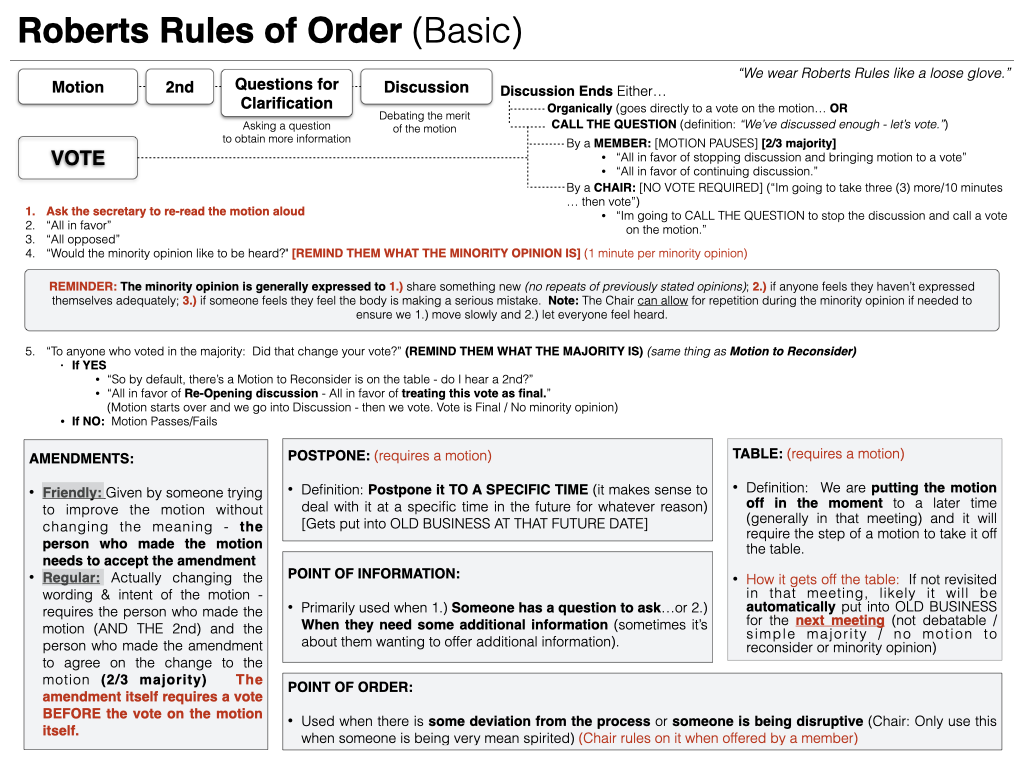
Robert’s Rules of Order – Use Them vs. Don’t Use Them
Over 140 years ago, Captain Henry Martyn Robert wrote the first edition of what has come to be known as “Robert’s Rules of Order” (the Rules). This first edition spanned 176 pages and was intended to be a brief and simple guide for the average meeting-goer. However, after its publication, Captain Robert received numerous letters from readers inquiring about situations not specifically addressed in the first edition. This correspondence led to the publication of a more robust second edition only five months later. In 2011 the eleventh was published, comprised of 669 pages of text, plus tables and an index, including responses to new questions and to technological developments since the publication of the prior edition (698 pages total!).
Here’s the deal – the Rules are designed to be a comprehensive guidebook for maintaining order and fairness, specifically when a large group of people meets to take action on behalf of an organization. Many service entities inside A.A. (Groups, Districts, Areas, and even the General Service Conference) have adopted various versions of The Rules to help them more effectively run their business meetings.
At our Area 65 GSR/DCM Orientation yesterday, we reviewed how our Area uses The Rules and how we apply them to process a motion. It was a fascinating conversation (call me a nerd). I had the privilege of presenting on this topic and at one point, I looked at both the in-person and virtual attendees (our Orientations are hybrid this year) and asked this question, “What is the primary purpose for using Robert’s Rules in our meetings?” We received a handful of answers from attendees including, clarity, efficiency of process, and fairness. Fairness was the answer I was really looking for in that moment, because of all the benefits of using them in a business meeting, they have a way of leveling the playing field and making the process fair for every attendee.
After our Orientation was over, one of the GSR’s who was in attendance came up to me and said, “Hey, did you know that the A.A. pamphlet talks about the use of Robert’s Rules in group business meetings? It provides an argument why group’s shouldn’t use them in their meetings.” I was intrigued by that because as many times as I’ve read that pamphlet, I didn’t remember that being in there – so I went back into the pamphlet to see exactly what it said, and while that GSR was correct that it’s in there, it wasn’t as black and white as they had suggested. From the pamphlet, “The A.A. Group” it shares on page 30 this, “Business meetings generally are scheduled before or after the group’s regular meeting. They tend to be informal, but custom varies from group to group. Some groups have tried observing Robert’s Rules of Order, a parliamentary procedure for running smooth meetings, only to find that many members are inexperienced in the procedures and feel too intimidated to speak up. Besides, there is the spiritual nature of our Fellowship, embodied in our Traditions and Concepts, which give ample guidance.”
While that passage shares experience that some groups may run into issues in implementing The Rules, it doesn’t suggest they don’t use them. In fact, it only states that lack of familiarity of them is the biggest obstacle – nothing about not using them. To me, what this says is that if an entity chooses to use them, it is crucial that they understand how to implement them – and – vital to ensure that the body understand them as well.
When I had the privilege of serving as the Area Chairperson for Area 49 (SENY) in Panel 65, it became painfully obvious that I wasn’t as familiar with The Rules as I would need to be to chair that Area’s Committee Meetings and Assemblies. In short order, my understanding of what I had been calling “Bob’s Rules of Order” up to that point (a much less formal application of them) when I was DCMC for Queens County in Panel 63 was no longer going to serve me. So, I had to do my homework and I learned them. I had another Officer in Panel 65 who knew them well and offered to help me learn. Once I was done with that learning, I created the “cheat sheet” you see above to actually hold in my hand as the body navigated votes at those Area meetings. It was a painful experience (due to my lack of knowledge of The Rules) but also an amazing teachable moment for me (and others) to learn so I could help run our business meeting more efficiently and fairly.
In the end, because of Tradition 4, each group gets to determine for themselves if they will use them or not, but I can tell you that it’s been my experience when a chair is fully informed on how they work and can implement them in the meetings they chair, far greater results are achieved.
Use them, don’t use them… but if you choose to use them – learn them! 🙂



